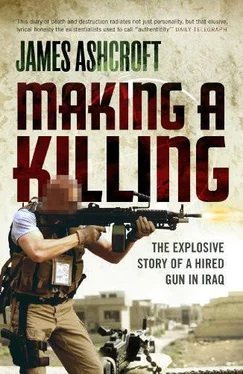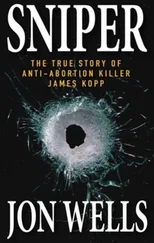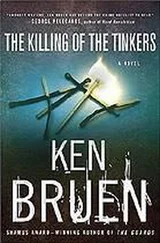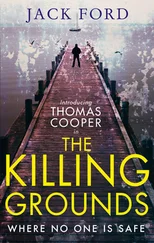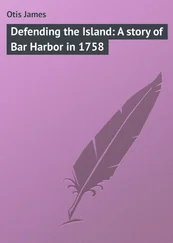We carried a couple of remote-control car transmitters with a switch taped permanently on SEND with the hope that any remote-controlled bombs would be detonated before we got to them. We had heard that some CF units had had good results with transmitters, but we had yet to set anything off. Terrorists tend to use the same frequency bands as toy manufacturers when they are unable to build more sophisticated devices; if they used normal radio frequencies the device would detonate as soon as anyone in the area used a radio, often when the bomb was still being set by the hapless bomber. We were aware that carrying remote-control car transmitters was a cheap trick and had a limited lifespan. The enemy was learning fast and would move quickly to more sophisticated transmitters and detonation initiation methods.
While Seamus at my side and Les in the back were focused on potential threats, I was keeping an eye out for access routes for my vehicle in case of trouble. The kerbs were high and although the 4 × 4 could mount them and go off road, the Opel wouldn’t have a hope.
In the event of a contact we had agreed a predetermined set of horn blasts to alert the rear driver what action to take: one blast meant the lead vehicle was disabled and (as long as the driver remembered to stick it into neutral) expected the rear vehicle to shunt it forward through any obstacle or at least out of the danger area. Two blasts told the rear driver that both vehicles were to turn around and head back in the opposite direction. Three blasts was the signal to de-bus, suppress the enemy with fire if required and await orders on the ground, which would either be to commandeer a local vehicle or house, or to withdraw on foot in a direction chosen by the team commander.
Straps were attached to towing points on both vehicles at all times and spare tyres were always the last thing to be loaded; easy to discard and for quick access when needed. We had agreed that the 4 × 4 would pull into the danger zone during any contact, and either block the traffic or shield the front vehicle from incoming fire with its own chassis and protect the principal by putting down a shitload of return fire from its two belt-fed guns.
Good security requires prior preparation, planning and drills combined with training, stamina, shooting practice, intuition, an eye for detail and physical strength coupled with an instinct for knowing when to use it. You have to know your maps, the local geography and conventions.
For example, if you are driving in the UK, you don’t eyeball other drivers. It’s impolite. In Iraq, it was the national pastime. On the street, people would stop and stare. On the road, old men cleaned their specs, women peered over their veils (guess they don’t see men as good-looking as us that often) and entire carloads of people would lean forward and gaze unblinkingly until you were out of sight.
As the driver in the lead vehicle, I was observing the custom, scrutinising everyone and looking for likely terrorists, which was a problem as most of the men looked exactly how you would expect terrorists to look: fierce and tribal with chequered headcloths, hard eyes and beards. Every man and boy over the age of thirteen had a moustache, a sign of masculinity, and something I couldn’t help finding amusing: a whole nation of Saddam Hussein lookalikes. You had to get used to the fact that not everyone was a terrorist.
I had allowed that evil insect doubt to creep into my mind during the initial screw-up at the empty airport. Now, everything was flowing along as it should be, even the traffic on Route Irish.
I was aware of the reassuring lump of the 9mm Browning on my chest; it was stuffed into a spare mag pouch as it was easier to draw from than the thigh rig while I was driving. My ‘long’, the AK, was stuffed between my left leg and the door, useless to me unless we de-bussed. My job was to drive not shoot. If an enemy did happen to pop up at my window I would use the 9 milly to give him the good news.
Seamus’s brand of army cockney resonated over the radio.
‘ Two geezers, 100 right. Static car 100 feet left. Derelict building 200 metres right .’
His stream of observations was interrupted by Cobus in the Yaapie wagon.
‘US patrol apprroachink vrom da rear.’
I hit the brakes and skidded into the dust at the side of the road along with the rest of the cars.
An armoured command vehicle and three soft Humvees raced by at about 100 klicks down the middle of the road. The gunners on the Humvees were exposed in open hatches, their weapons trained left and right, front and rear. They were blasting their horns and Iraqi traffic peeled over to the side like the Red Sea parting. They had learned that non-compliance resulted in warning bursts followed quickly by disabling bursts. Sometimes so quickly, in effect, that there was actually just one long burst of fire.
Lori seemed shaken by the sudden halt. ‘Do they have to do that?’ she asked.
‘It’s standard procedure,’ said Les.
‘That’s why the locals hate us,’ Lori remarked. ‘It’s the same in Kabul.’
‘At least they’re clearing the road for us,’ Les explained. ‘If there are any ragheads planning to take a pop at the cars, they’ll hit the patrol first.’
Lori was taking it all in. I caught her eyes for a moment in the rear-view mirror. I couldn’t believe that Les had been picked randomly to be bodyguard that day.
An old man on a donkey cart glided by, oblivious, as I pulled back on to the highway, Etienne on my tail. Dust swirled through the air. I could taste grit in my mouth even though my window was only down an inch. I would almost have preferred rain to clean the air, but in a desert country unused to rainfall there was no drainage and the roads flooded instantly, hence the high kerbs.
Before we were back up to speed, the rest of the traffic curved off the exit ramp leading into the city and we carried straight on through a channel of NO ENTRY signs. The road narrowed and twisted through concrete blocks laid out in traffic-controlling chicanes.
Seamus taped the plastic, A4-sized American flag in the windscreen; the South Africans would be doing the same. We didn’t show the flags when we were on the open road.
As I snaked my way through the concrete barriers towards the Green Zone I recalled that ten women and children had been shot to pieces a week before when the van they were in failed to stop at an entry gate. The driver had ignored the US soldier’s hand signals and had continued moving towards the checkpoint. ‘We’re sorry about that, but there’s bound to be some spillage,’ US General Richard Myers was reported to have said.
Collateral damage had become spillage and either way it meant more dead innocents.
The road swung in a final curve and Gate 12 came into view.
‘Nearly home,’ Les said to Lori.
This was the BIAP road’s main access to the Green Zone. The BIAP Gate consisted of two checkpoints, 40 metres apart, one for entry and one for exit; they were part of the one-way system. Across the concrete barricades to our left, a line of cars were exiting. The process was slow.
A disused flyover, also on our left, was pressed tight against the BIAP exit gate. Beyond the flyover stood a long terrace of three-storey, flat-roofed buildings. Like many buildings in Baghdad, they seemed abandoned, half built or half demolished, the washing hanging from windows and the occasional potted magnolia adding a melancholic air. The building nearest the gate was a concrete skeleton gutted in the war.
To our right was a wall and beyond stood a derelict palace bombed during the invasion and needing severe restoration. I could tell that Les’s sapper heart was dying to get out there and put a decent roof on the place.
Читать дальше
